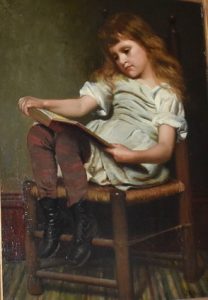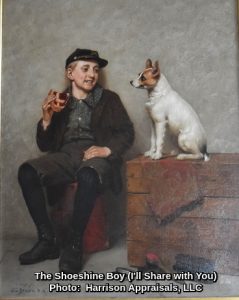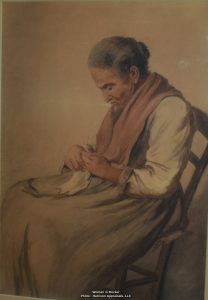Who was John George Brown?
 JOHN GEORGE BROWN (1831-1913) was an English born artist and British citizen who became famous in Victorian America for his idealized portraits of street children. And while his popularity as a genre painter has waned in recent years, his work once adorned the walls of the wealthiest art patrons in the United States.
JOHN GEORGE BROWN (1831-1913) was an English born artist and British citizen who became famous in Victorian America for his idealized portraits of street children. And while his popularity as a genre painter has waned in recent years, his work once adorned the walls of the wealthiest art patrons in the United States.
Early Life
Brown began life in Durham, England in 1831. By the age of 14, he was apprenticed to a glass factory at Newcastle-on-Tyne where his father hoped he would learn the trade of glass-cutter. Although factory work was not an uncommon situation for Victorian children—in fact, by as late as 1880, one glass factory in the United States reported having fifty-three fourteen year olds and two ten year olds among its employees—Brown did not particularly enjoy his new position. In fact, his true calling was painting. While working at the glass factory, Brown studied nights at the School of Design in Newcastle. When his seven year apprenticeship came to an end in 1853, he sailed to New York.
It was in New York that Brown found success as an artist. Although he initially supported himself by working in the Brooklyn Flint glass factory, Brown enrolled in the Graham Art School and began to devote himself to art full time following his marriage to Mary Own in 1855. With the help of Mary’s father—the owner of Brooklyn Flint—Brown secured a space at the Tenth Street Studio Building and enrolled in the National Academy of Design. By the 1860s, the young artist had cultivated a reputation among the city’s art patrons.
Genre Painter
 Brown painted both landscapes and portraits. However, by the mid-1870s, he began focusing almost exclusively on painting the working children of late 19th century America. Like his contemporary, English author Charles Dickens, Brown was deeply affected by the poverty he experienced as a youth. His detailed but stylized portraits of bootblacks, street musicians, flower sellers and street vendors reveal a romanticized vision of Victorian poverty that appealed to art collectors of the period. Years later, when asked why he painted so many street children, Brown replied “I too was once a poor lad like them”.
Brown painted both landscapes and portraits. However, by the mid-1870s, he began focusing almost exclusively on painting the working children of late 19th century America. Like his contemporary, English author Charles Dickens, Brown was deeply affected by the poverty he experienced as a youth. His detailed but stylized portraits of bootblacks, street musicians, flower sellers and street vendors reveal a romanticized vision of Victorian poverty that appealed to art collectors of the period. Years later, when asked why he painted so many street children, Brown replied “I too was once a poor lad like them”.
Brown’s street urchin paintings include specific themes that contributed to their popularity. He was especially interested in painting bootblacks. In fact, Brown painted so many Victorian shoeshine boys that he was nicknamed, “the bootblack Raphael”. In most of his bootblack portraits, Brown’s subject appears in tattered clothing and sits on a crate or shine box. The child is shown either looking directly at the viewer or interacting with a dog. Dogs were another favorite of the artist and they appear in many of his paintings. In fact, there are more than fifty known Brown paintings that include a dog begging, playing or interacting with its young owner. Most of the dogs appear to be terriers or terrier mixed breeds.
Later Years
 Towards the end of his life, Brown changed his focus yet again. In the 1890s, the artist began painting portraits of the elderly. One scholar has speculated that Brown’s later portraits depicting seniors in rural settings represent the artist’s longing for “the country’s lost agrarian past”; however, it is just as likely that Brown’s later work reflects a growing sense of his own mortality. His subjects are often shown in a rocker or ladderback chair and appear lonely and forgotten. The smiling faces of Brown’s street urchin paintings have been replaced with the serious countenances of infirm and dependent elders painted in dark cottages. While many of these works are oils on canvas, Brown also returned to watercolor, a medium he used in the mid-19th century.
Towards the end of his life, Brown changed his focus yet again. In the 1890s, the artist began painting portraits of the elderly. One scholar has speculated that Brown’s later portraits depicting seniors in rural settings represent the artist’s longing for “the country’s lost agrarian past”; however, it is just as likely that Brown’s later work reflects a growing sense of his own mortality. His subjects are often shown in a rocker or ladderback chair and appear lonely and forgotten. The smiling faces of Brown’s street urchin paintings have been replaced with the serious countenances of infirm and dependent elders painted in dark cottages. While many of these works are oils on canvas, Brown also returned to watercolor, a medium he used in the mid-19th century.
Legacy
Although by the early 20th century John George Brown’s popularity had diminished, his paintings had made him a wealthy man. His penchant for copyrighting his most popular works, which were eventually reproduced as inexpensive lithographs, earned him royalties well into his later years. Brown died in New York in 1913 at age 81. At the time of his death, he was recognized as the wealthiest genre painter in the United States.
C. Robert Harrison 3/28/23
1 “Jobs in a 19th Century Glass Factory”, Corning Museum of Glass. Retrieved from https://www.cmog.org/article/jobs-19th-century-glass-factory on 3/16/23.
2 “John George Brown”, Wikipedia Foundation (November 10, 2022), https://en.wikipedia.org/wiki/John_George_Brown (Hereafter cited as “Brown Bio”)
3 Letha Clair Robertson, “John George Brown”. The Montgomery Museum of Fine Arts (April 19, 2004). Retrieved online from https://collection.mmfa.org/artist-maker/info/344?sort=3 on 3/23/23.
4 Letha Clair Robertson, “John George Brown”. The Montgomery Museum of Fine Arts (April 19, 2004). Retrieved online from https://collection.mmfa.org/artist-maker/info/344?sort=3 on 3/23/23.
5 “Brown Bio”.
6 Letha Clair Robertson, “John George Brown”.







